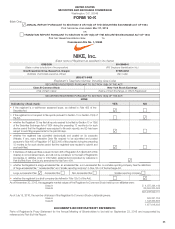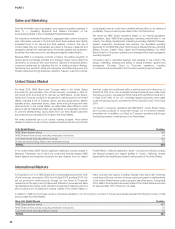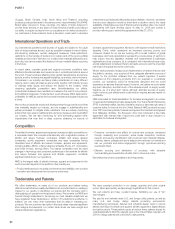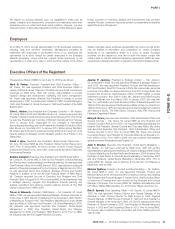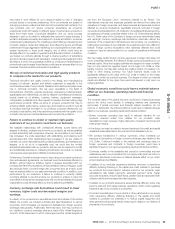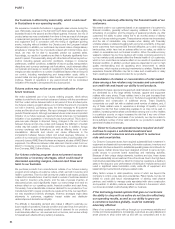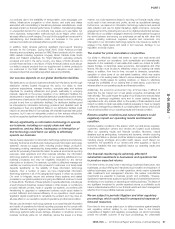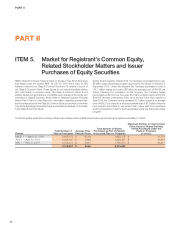Nike 2016 Annual Report Download - page 10
Download and view the complete annual report
Please find page 10 of the 2016 Nike annual report below. You can navigate through the pages in the report by either clicking on the pages listed below, or by using the keyword search tool below to find specific information within the annual report.
PART I
may make it more difficult for us to respond rapidly to new or changing
product trends or consumer preferences. All of our products are subject to
changing consumer preferences that cannot be predicted with certainty. Our
new products may not receive consumer acceptance as consumer
preferences could shift rapidly to different types of performance products or
away from these types of products altogether, and our future success
depends in part on our ability to anticipate and respond to these changes. If
we fail to anticipate accurately and respond to trends and shifts in consumer
preferences by adjusting the mix of existing product offerings, developing new
products, designs, styles and categories, and influencing sports and fitness
preferences through aggressive marketing, we could experience lower sales,
excess inventories or lower profit margins, any of which could have an
adverse effect on our results of operations and financial condition. In addition,
we market our products globally through a diverse spectrum of advertising
and promotional programs and campaigns, including social media and online
advertising. If we do not successfully market our products or if advertising and
promotional costs increase, these factors could have an adverse effect on our
business, financial condition and results of operations.
We rely on technical innovation and high-quality products
to compete in the market for our products.
Technical innovation and quality control in the design and manufacturing
process of footwear, apparel and athletic equipment is essential to the
commercial success of our products. Research and development plays a key
role in technical innovation. We rely upon specialists in the fields of
biomechanics, chemistry, exercise physiology, engineering, industrial design,
sustainability and related fields, as well as research committees and advisory
boards made up of athletes, coaches, trainers, equipment managers,
orthopedists, podiatrists and other experts to develop and test cutting edge
performance products. While we strive to produce products that help to
enhance athletic performance, reduce injury and maximize comfort, if we fail
to introduce technical innovation in our products, consumer demand for our
products could decline, and if we experience problems with the quality of our
products, we may incur substantial expense to remedy the problems.
Failure to continue to obtain or maintain high-quality
endorsers of our products could harm our business.
We establish relationships with professional athletes, sports teams and
leagues to develop, evaluate and promote our products, as well as establish
product authenticity with consumers. However, as competition in our industry
has increased, the costs associated with establishing and retaining such
sponsorships and other relationships have increased. If we are unable to
maintain our current associations with professional athletes, sports teams and
leagues, or to do so at a reasonable cost, we could lose the on-field
authenticity associated with our products, and we may be required to modify
and substantially increase our marketing investments. As a result, our brands,
net revenues, expenses and profitability could be harmed.
Furthermore, if certain endorsers were to stop using our products contrary to
their endorsement agreements, our business could be adversely affected. In
addition, actions taken by athletes, teams or leagues associated with our
products that harm the reputations of those athletes, teams or leagues, could
also seriously harm our brand image with consumers and, as a result, could
have an adverse effect on our sales and financial condition. In addition, poor
performance by our endorsers, a failure to continue to correctly identify
promising athletes to use and endorse our products or a failure to enter into
cost-effective endorsement arrangements with prominent athletes and sports
organizations could adversely affect our brand, sales and profitability.
Currency exchange rate fluctuations could result in lower
revenues, higher costs and decreased margins and
earnings.
A majority of our products are manufactured and sold outside of the United
States. As a result, we conduct purchase and sale transactions in various
currencies, which increases our exposure to fluctuations in foreign currency
exchange rates globally. Additionally, there has been, and may continue to
be, volatility in currency exchange rates as a result of the United Kingdom’s
June 23, 2016 referendum in which voters approved the United Kingdom’s
exit from the European Union, commonly referred to as “Brexit.” Our
international revenues and expenses generally are derived from sales and
operations in foreign currencies, and these revenues and expenses could be
affected by currency fluctuations, specifically amounts recorded in foreign
currencies and translated into U.S. Dollars for consolidated financial reporting,
as weakening of foreign currencies relative to the U.S. Dollar adversely affects
the U.S. Dollar value of the Company’s foreign currency-denominated sales
and earnings. Currency exchange rate fluctuations could also disrupt the
business of the independent manufacturers that produce our products by
making their purchases of raw materials more expensive and more difficult to
finance. Foreign currency fluctuations have adversely affected and could
continue to have an adverse effect on our results of operations and financial
condition.
We may hedge certain foreign currency exposures to lessen and delay, but
not to completely eliminate, the effects of foreign currency fluctuations on our
financial results. Since the hedging activities are designed to lessen volatility,
they not only reduce the negative impact of a stronger U.S. Dollar or other
trading currency, but they also reduce the positive impact of a weaker U.S.
Dollar or other trading currency. Our future financial results could be
significantly affected by the value of the U.S. Dollar in relation to the foreign
currencies in which we conduct business. The degree to which our financial
results are affected for any given time period will depend in part upon our
hedging activities.
Global economic conditions could have a material adverse
effect on our business, operating results and financial
condition.
The uncertain state of the global economy continues to impact businesses
around the world, most acutely in emerging markets and developing
economies. If global economic and financial market conditions do not
improve or deteriorate, the following factors could have a material adverse
effect on our business, operating results and financial condition:
•Slower consumer spending may result in reduced demand for our
products, reduced orders from retailers for our products, order
cancellations, lower revenues, higher discounts, increased inventories and
lower gross margins.
•In the future, we may be unable to access financing in the credit and capital
markets at reasonable rates in the event we find it desirable to do so.
•We conduct transactions in various currencies, which increases our
exposure to fluctuations in foreign currency exchange rates relative to the
U.S. Dollar. Continued volatility in the markets and exchange rates for
foreign currencies and contracts in foreign currencies could have a
significant impact on our reported operating results and financial condition.
•Continued volatility in the availability and prices for commodities and raw
materials we use in our products and in our supply chain (such as cotton or
petroleum derivatives) could have a material adverse effect on our costs,
gross margins and profitability.
•If retailers of our products experience declining revenues or experience
difficulty obtaining financing in the capital and credit markets to purchase
our products, this could result in reduced orders for our products, order
cancellations, late retailer payments, extended payment terms, higher
accounts receivable, reduced cash flows, greater expense associated with
collection efforts and increased bad debt expense.
•If retailers of our products experience severe financial difficulty, some may
become insolvent and cease business operations, which could negatively
impact the sale of our products to consumers.
•If contract manufacturers of our products or other participants in our supply
chain experience difficulty obtaining financing in the capital and credit
markets to purchase raw materials or to finance capital equipment and
other general working capital needs, it may result in delays or non-delivery of
shipments of our products.
NIKE, INC. 2016 Annual Report and Notice of Annual Meeting 63
FORM 10-K


